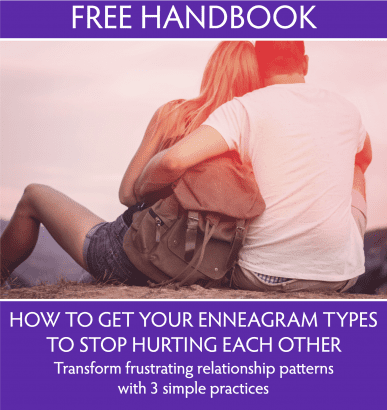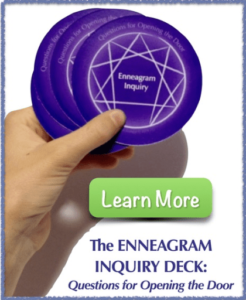Why is it that when I try harder in relationship, it can make things worse?
Why when we care about each other, do we keep hurting each other in the same ways?
Our Enneagram types can, by their very architecture, keep us dissatisfied and in conflict in relationship. At least when they are on auto-pilot.
This in itself is a bit of a paradox. It is hard to accept that my personality or ego-structure would be undermining me and my happiness. After all, I kind of think of my personality as me. It’s who I take myself to be, ordinarily. Why would I habitually or automatically be undermining myself?
In this article, I will offer you some ways to reframe this conundrum and four practices to help you work with the dilemmas we find ourselves in over and over.
The Conditions for Growth
Relationships, by their very nature, ask us to develop and grow beyond the structures we’ve built up to this point. And when we “try harder” using our same-old structures and approaches, we often intensify our usual dynamics, rather than finding new, inspired ways through.
This might suggest that we need to get rid of the personality structure or to change it to have a different experience, but that is not so. The main thing we need to do is to watch the patterns and soften our identification with them.
As Carl Rogers put it, “The curious paradox is that when I accept myself just as I am, then I can change.” In inner work with the Enneagram we cultivate the capacity of our “inner observer” to help us witness the personality patterns without having to counter them or indulge them. Acknowledging them with acceptance shifts the level at which we are playing the game of life.
A definition of paradox is: a statement or proposition that, despite apparently sound reasoning from acceptable premises, leads to a conclusion that seems senseless, logically unacceptable, or self-contradictory.
When faced with paradox we can feel confounded, or even judge ourselves as stupid. Yet, all of us are navigating paradoxes every day!
I’d like you to consider that when you find yourself caught in paradox, it is an invitation to open to your next layer of development.
 Carl Jung tells us it is crucial to learn to “hold the tension of the opposites.” The creative tension of “being with both” creates in us the pressure necessary for the process of transformation to occur. He describes being human as a being a “vessel filled with divine conflict.”
Carl Jung tells us it is crucial to learn to “hold the tension of the opposites.” The creative tension of “being with both” creates in us the pressure necessary for the process of transformation to occur. He describes being human as a being a “vessel filled with divine conflict.”
So if I am Enneagram type Two, the opportunity would be to learn to become really present to these two truths at the same time:
* My approach is all about getting love.
* My approach reliably leaves me feeling rejected and can unintentionally push others away.
Baffling, uncomfortable, painful even, if I sit with this long enough, something new will want to come through. (Thank goodness!)
How Do We Break Through?
I offer below some awareness practices and responses that you can try when you have a hunch that you might be experiencing your own Enneagram relationship paradox(es). These are meant as individual inner practices.
The processes may be rather difficult to engage at first, not because the exercises themselves are complex and not because they take a tremendous amount of effort. They can be difficult because these layers (of unconscious false assumptions, compensations, unintended consequences, and paradoxes) can be both challenging to notice in the first place and hard to imagine as untrue. After all, they are like the water we’re swimming in and they undergird our basic understanding about how the world works.
In many ways our egos do not want us to realize that these basic perspectives are untrue— it feels destabilizing. And it can be destabilizing— to our “usual way,” to our default orientation, to the “home” that we are starting to experience more as house arrest.
 So even an act of entertaining the notion that our usual assumptions and approaches are at least incomplete (if not missing something important) can be helpful in loosening things up a little in our structure. These little loosenings keep opening the pathways inside to more present and easeful living.
So even an act of entertaining the notion that our usual assumptions and approaches are at least incomplete (if not missing something important) can be helpful in loosening things up a little in our structure. These little loosenings keep opening the pathways inside to more present and easeful living.
So, if these exercises feel counter-intuitive, you are probably on the right track.
I’ll outline the approaches first and then give you an example to illustrate a few of them. The list of the Unconscious False Assumptions, Compensations, Unintended Consequences, and Paradoxes for each of the nine types can be found HERE.
Approaches to Transcend the Paradoxes
- Sleuth for your “UFA.” Ask yourself:
* Can I notice my Unconscious False Assumption (UFA) at work in me?
* If so, would I be willing to question it or suspend it for a moment?
* Can I wonder: “What if it were not true that __(UFA)__? What else might be possible?”
2. Watch for your path of least resistance. Ask yourself:
* Can I notice my compensation compelling me to continue my usual approach?
* If so, can I pause and ground myself, paying attention to the sensations and impulses it invokes without trying to change or judge anything?
* Can I wonder: “May I be with these sensations and impulses with presence and curiosity?”
3. Let the consequences get your attention. Ask yourself:
* Can I begin to notice any of my type’s Unintended Consequences for myself or others?
* What happens when I sit with these phenomena without trying to change or judge anyone? What do I notice in my body? Heart? Mind?
* Can I wonder: “What else might be possible?
4. Hang out with your paradox
One of the mysterious (and cool, though sometimes maddening) things about a paradox is that it can’t be “solved” by insisting on its contents or premises.
When you are able to recognize that your paradox is at work in you, here are some potential ways to engage it:
Experience the paradox from both sides
* Give one side of the paradox some real attention. Taking several slow breaths, notice how your body, heart and mind respond to this aspect of the paradox. Notice the tone, energy and qualities it invokes. When you have a direct sense of it, let that focus rest.
* Repeat this with the second side of the paradox.
* Allow yourself to move back and forth between these two slowly, alternating, until something new arises.
Explore the places between the paradox
* Is it possible to acknowledge both sides of the paradox at once? Can you feel their presence simultaneously in your body, heart, or mind? Do they “meet” somewhere or do they seem far apart?
* Place your observing self in between, or above, or below, the two aspects. Can you remain there, breathing and grounding, and let both be “true” in their own way?
* Stay with this dynamism until something new arises.
Let the paradox work on you
When we can hold seemingly disparate things at the same time, and can remain present long enough, alchemy can happen. Rather than insisting that one side is more true or more important, what if we could simply show up for the mystery and let it unfold in us? The kind of insight that can appear from this kind of stance usually surprises and satisfies, but in a different way than our ordinary mind could conjure.
Melting Maria’s Heart
An example of using this approach can be seen below with Maria, who orients from Type One. As I lined out in Can’t Get No Satisfaction? 9 Paradoxes in Relationship, Type One experiences the following dilemmas:
Type One’s Unconscious False Assumption
I am not how I should be, and thus am not acceptable.
Type One’s Compensation
I work hard to do what’s right so that I will be worthy and lovable.
Type One’s Unintended Consequences
This striving has me resist my heart and my instincts, leaving me frustrated and feeling cut off from love.
Others experience my striving as judgmental, making them afraid to be close or open up.
Type One’s Paradox
My approach to being lovable blocks me from feeling or receiving love toward myself or from others.
Maria has been working with her type tendencies for some time. She begins the reflective process by catching herself in her striving mode. She notices that she’s in full diligence mode: working hard for a good cause, and putting off her own needs to make sure her work is excellent. The striving got her attention when she was feeling resentment toward others on her team who don’t seem to be working as hard as she is.
After she notices the resentment and the striving, Maria chooses to pause and ground herself through her feet and with her breath. Paying attention to her sensations, she notices a strong tension through her core, and also in her jaw and brow. Her mind has a sharp, edgy quality and her heart feels tight and closed. “I don’t like this,” she thinks.
Even though it’s uncomfortable, Maria coaches herself to stay with her sensations, and she is relieved to find they are not overwhelming as long as she can continue to breathe and stay grounded. Typically she would be tempted to either push the sensations and thoughts away or to indulge them and be fueled by them (“Yes! My teammates are slackers!”), but right now she can observe them and can imagine that they are showing up to teach her something about herself in this moment.
With the attention and support she is giving herself, Maria begins to wonder about her own reactions as they relate to her inner experience, instead of focusing on whether her coworkers are up to par.
She asks herself things like:
* Are these reactions familiar?
* What might they be trying to do for me in this moment?
* What are these reactions invested in? A certain story/“truth”?
* What are they trying keep me away from?
* What are they trying to tell me?
As Maria explores these questions with curiosity, she starts to feel her heart melt a bit. She remembers that it is stressful and hardening to always be pushing herself to the highest standards. It’s can be a little lonely and harsh. It’s not pleasant feeling judgment for her teammates— it adds to her dissatisfaction (and theirs).
From this point of view, with her heart softening, Maria can see her type One paradox at work. Her approach to being good and doing the right thing is causing stress and pain for herself and for her teammates (and for her family when she finally comes home from work). Trying to be good is creating what could be seen as “bad.”
Tempted to judge herself for this conundrum, she catches the old trick of the Inner Critic, and comes back to her direct experience by breathing, grounding, and noticing. Back in touch with herself, Maria stays with it a bit longer and wonders, “What might be another way to be with this?”
She leans into the question, listening from her whole self. She has to resist focusing on the quick answers her mind and ego can serve up. After several more breaths, something new just “drops in.”
OH!
* Another way could be… to stay in touch with my own heart when I’m working.
* Another way could be… to allow myself time to connect with and include my own (human) needs when considering * how long and hard to work on a project.
* Another way could be… looking for what my coworkers are contributing that may be different from my way, and being curious about what values are driving them.
By staying in touch with herself and waiting through the tension of the paradox, Maria has opened up to her heart and has received inspiration that could help her move through the dilemma when it arises in the future.
So, Maria used parts of approaches 2, 3 and 4 above, and not only felt less trapped in her type pattern, but also accessed a sweetness toward herself and curiosity toward others that was renewing and encouraging.
Cooperating with Paradox
This example illustrates how these principles can work on us when we “cooperate” with paradox and what it’s inviting us to. It’s not wrong or bad that we have these dilemmas. It’s actually learning how to work with them that opens up secret keys to life and learning.
Jung said, “…all the greatest and most important problems of life are fundamentally insoluble…. They can never be solved, but only outgrown.”
I hope these practices gives you a taste of what’s possible as we say yes to our dilemmas and to showing up for them. The more we can acknowledge our paradoxes, the more likely we can influence them and the more they can develop us.
This stance is what mature relationship is all about.
I’d love to hear what you notice about your own paradoxes in relationship.
Would you share in the comments below?









